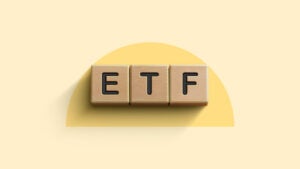Best gold ETFs: Top funds for investing in gold

Investors have many ways to gain exposure to gold, from directly purchasing gold bullion to more indirect methods like owning shares of public mining companies. While some funds invest directly in the physical metal, others manage a portfolio of gold-related stocks.
To get in on the action, the most efficient approach for retail investors is through exchange-traded funds (ETFs) with gold as their underlying asset. Gold ETFs are convenient because they can be purchased through most online brokers, often at a low cost. Here’s a look at some of the most widely held gold ETFs.
Top gold ETFs
Bankrate selected its top funds based on the following criteria:
- U.S. funds that appear in ETF.com’s screener for gold or materials ETFs
- Assets under management of at least $800 million
- Expense ratios under 0.60 percent
(ETF performance data mentioned below is as of Sept. 29, 2025.)
SPDR Gold Shares (GLD)
GLD is one of the most popular ETFs available. The fund invests in physical gold, and its performance is highly correlated to gold spot prices.
- 2025 YTD performance: 43.2 percent
- Five-year annual return: 14.7 percent
- Expense ratio: 0.40 percent
iShares Gold Trust (IAU)
Another popular option, this fund also tracks the spot price of gold by investing in gold bars held in vaults around the world. But compared to GLD, its expense ratio is lower.
- 2025 YTD performance: 43.4 percent
- Five-year annual return: 14.8 percent
- Expense ratio: 0.25 percent
iShares MSCI Global Gold Miners ETF (RING)
RING is a popular ETF in the global mining sector. This BlackRock ETF gives you exposure to all the major international companies that derive most of their revenues from gold mining — and with an expense ratio lower than other similar funds.
- 2025 YTD performance: 128.1 percent
- Five-year annual return: 16.9 percent
- Expense ratio: 0.39 percent
VanEck Junior Gold Miners ETF (GDXJ)
This fund invests in foreign small-cap mining companies that generate at least half of their revenues from gold and silver. Nearly 50 percent of these companies are based in Canada.
- 2025 YTD performance: 125.1 percent
- Five-year annual return: 13.8 percent
- Expense ratio: 0.51 percent
GraniteShares Gold Trust (BAR)
This ETF invests directly in gold held in a London vault and overseen by ICBC Standard Bank, and its price should track the spot price of the precious metal relatively closely.
- 2025 YTD performance: 43.5 percent
- Five-year annual return: 14.9 percent
- Expense ratio: 0.175 percent
Reasons to invest in gold
Investors may find gold to be an attractive investment for a variety of reasons.
- Diversification: The most common reason retail investors buy gold ETFs is diversification. Owning various investments minimizes the risk of having too much exposure to a single asset.
- Lower correlation to the stock market: Historically, gold has had a low correlation to the stock market, smoothing a portfolio’s returns. For example, during the financial crisis in 2008, gold prices rose 2 percent while the S&P 500 index plunged 37 percent. More recently, gold prices have spiked this year in the wake of recession worries and tariff tensions.
- Hedge against inflation: Gold may also serve as a hedge against inflation because it’s performed well during periods of high inflation in the past, particularly the 1970s. But there’s no guarantee gold will increase alongside inflation over time.
- Safe haven asset and store of value: Additionally, in times of political or social turmoil, investors often flock to gold as a safe haven, leaving behind more volatile assets.
Disadvantages of buying gold
But gold is not without its flaws as an investment either, including the following reasons.
- Volatile price in the short term: While gold has retained its value over the years, the commodity has been susceptible to erratic moves in the short term. In 2021, many gold funds decreased in value as investors sold gold to purchase riskier assets amidst a boom in the stock and cryptocurrency markets. Now, gold returns have started to pick back up as investors are turning back to the metal for stability. Investors should be wary of these swings in price as market conditions change.
- Hard to estimate the value of gold: Some investors also argue that, unlike stocks, valuations for gold can be tricky to estimate, since it doesn’t have earnings or cash flow metrics to analyze.
- Gold doesn’t offer cash flow to investors: Gold doesn’t generate cash flow, a turn-off for those looking for passive income like dividends.
- May be taxed as a collectible: Depending on the type of gold asset you own, profits from selling gold ETFs can be taxed as collectibles rather than ordinary investments, meaning you may pay a higher tax rate than the more attractive long-term capital gains rate. These rules only apply for holdings outside tax-advantaged accounts like a 401(k) or an IRA.
- Much better long-term returns elsewhere: While gold may perform well over shorter periods, investors can find better long-term returns by investing in a diversified portfolio of stocks or a stock ETF. That’s one key reason to not buy physical gold as part of Costco’s promotion.
How to buy gold ETFs
When selecting gold ETFs, decide whether you want exposure to physical gold or public companies involved in gold mining. These two asset classes have different risk profiles.
As you plan your investment strategy, here are four steps to guide you:
- Determine your financial goals: The investments you choose depend on what you are trying to achieve. For example, someone saving to buy a second home will have a different investment strategy from someone saving for their child’s college education. So always let your financial objectives drive your decision-making.
- Research gold funds: When selecting commodity ETFs, pay attention to factors such as the fund’s performance, expense ratios, top holdings and assets under management. Investors can find this information in a fund’s prospectus.
- Outline your asset mix: Before investing, do an inventory of all your assets, and calibrate your portfolio accordingly. Remember, the key is to remain diversified.
- Know what you own: By periodically reviewing your investments, you can take charge of your finances and make any necessary adjustments. Leverage any free resources from your broker, such as meeting with a financial planner, and always ask questions. Ultimately, there’s no such thing as a hands-off investment.
You can buy gold ETFs at any of the best brokers for stock trading.
Get expert guidance for managing your investments or planning for retirement. Bankrate’s AdvisorMatch can connect you to a CFP® professional to help you achieve your financial goals.
Bottom line
Gold has maintained a coveted status in society, and for investors gold serves as a portfolio hedge against market volatility and geopolitical unrest.
Note: Giovanny Moreano wrote a previous version of this story.
Editorial Disclaimer: All investors are advised to conduct their own independent research into investment strategies before making an investment decision. In addition, investors are advised that past investment product performance is no guarantee of future price appreciation.
Why we ask for feedback Your feedback helps us improve our content and services. It takes less than a minute to complete.
Your responses are anonymous and will only be used for improving our website.






